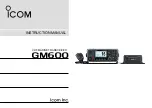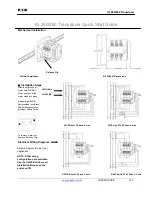
1.x.4
1. Symbol
The 1st symbol determines which symbol is displayed in the function field at first position. You can
choose between capital letters, punctuation marks, numbers and selected symbols.
If a space is stored for the 1st, 2nd and 3rd symbols, no function is performed for this function field.
Selection: Values [ 0 … 9 , A … Z , Ä , Ö , Ü , , _ , . , - , + , = , : , ! , ? , # ,
,
,
,
,
,
,
,
,
,
,
,
,
,
,
,
,
,
🔒
,
🔓
,
🕒
,
]
1.x.5
2. Symbol
The 2nd symbol determines which symbol is displayed in the function field at the second position.
For details see point 1.x.4.
1.x.6
3. Symbol
The 3rd symbol determines which symbol is displayed in the function field at the third position. If the total
length of all 3 symbols is too long for the function field, the 3rd symbol is hidden.
For details see point 1.x.4.
2
Addressing
Here the addressing is set. Details see point 5.
2.1
Mode
Here you can set whether the addressing mode is deactivated or activated with 1, 2 or 3 digits.
Selection: Values [ OFF , 0 … 9 , 00 … 99 , 000 … 999 ]
3
Key lock
The key lock is set here. See point 5 for details.
3.1
Mode
Here you can set whether the key lock is deactivated or a code entry is required to operate the remote
control.
Selection: Values [ OFF , CODE ]
3.2
Code
The code that releases the key lock (if Mode = Code) can be set here.
Input: Value Range [ 0 … 9999 ]
4
Display
Parameters for display are set here
4.1
ACK View
Here you can set the acknowledge view. By default, transmission and acknowledgement information is
displayed in the header only.
In the extended view, this information is displayed in detail in a separate view during the transmission.
Selection: Values [ STANDARD , EXTENDED ]
4.2
FCT View
The function view can be set here. By default, the 6 function keys (index 1-6) and the 4 arrow keys are
available for function triggering. Only a single function page will be shown on the display.
In the extended view, 3 function pages are available. The arrow keys are used exclusively for navigation
between the function pages. The 3 function pages provide three definitions for each function key (index
1-6). The currently displayed page determines which definition is used.
Selection: Values [ STANDARD , EXTENDED ]
5
Extended
Some specific settings can be made here.
5.1
Frequency
Here you can set the working frequency. This setting is not automatically applied. The supply voltage of
the hand-held transmitter must be interrupted for a short time in order to apply this setting. Transmitter
and receiver must always be set to the same frequency.
Selection: Values [ FREQ. 1 , FREQ. 2 ]
5.2
Mute
Here you can set whether the hand-held transmitter outputs audio signals as described above or it
operates silently.
Selection: Values [ OFF , ON ]
5.3
Standby (s)
Here you can set after how many seconds the hand-held transmitter switches to standby mode if no key
has been pressed in the meantime. In standby mode, the display and other components are deactivated
to save power. To return to normal mode, simply press any key. When returning from standby mode, the
initial view is displayed instead of the last view.
Input: Value range [ 0 … 9999 ]
5.4
Language
The language of the hand-held transmitter display can be set here.
Selection: Values [ DEUTSCH , ENGLISH ]
-
11
-






































